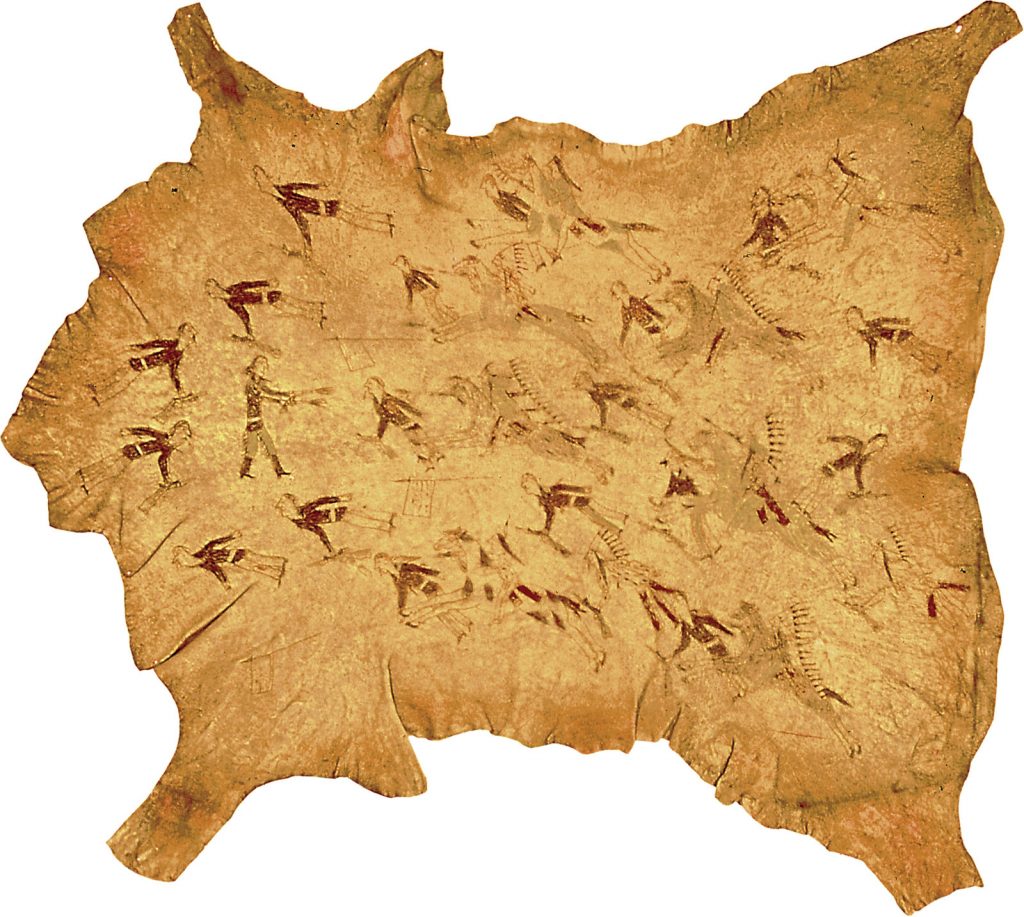Vision and Division. One’s a power. The other’s a weakness

The Battle with three names
145 years ago this Friday, a battle with three names took place in modern day Montana. ‘The Battle of the Greasy Grass’ is more commonly known as ’The Battle of the Little Bighorn’. It’s even more famously known as ‘Custer’s Last Stand’. Whichever name you use, it’s a battle with a very important lesson. Vision is powerful. Division is weakness.
War wasn’t inevitable
During the 1860’s, the American plains were under constant invasion from white settlers. Treaty after treaty was agreed to keep the peace. Tribe after tribe believed the promises it was given. And one by one, each of those treaties was reneged on or renegotiated by the U.S. Government. Trust is easily lost; and less easily recovered.
The Second Fort Laramie Treaty of 1868 had guaranteed the Lakota, Dakota and Arapaho exclusive possession of territory west of the Missouri River. No white settlers were allowed entry to the Black Hills, let alone the right to settle there. But ever-increasing numbers of gold prospectors ignored the treaty and began settling in the sacred Black Hills. As the white settlers encroached ever further, tensions grew to breaking point.
Rather than uphold its own treaty, the U.S. Government tried to persuade the Lakota Sioux to ‘sell’ their spiritual homeland. Unsurprisingly, all offers were rejected. Money was a meaningless man-made concept. Their spiritual homeland was priceless and couldn’t be given away. Who would trade a sustainable life for every future generation, for just a few pieces of metal? A sale was impossible. There was literally no common ground. And conflict often follows when there’s a wide cultural mismatch.
Instead of respecting the decision not to sell, the U.S. Government issued an order that all Native Americans had to come into arbitrary reservations by the end of January 1876, or be deemed ‘hostile’. From the moment that policy was enacted, war became inevitable.
Choose wisely or you lose
In response to the Government order, many warriors and their families came into the reservations, believing the Government’s promises of safety and a good life. However, the families who took the peaceful path had been hoodwinked. The food provided was poor quality and intermittent. The treatment handed out was grievous and unfair. It was a life, but a pale imitation of life on the plains.
Other groups of warriors defied the Government’s order and refused to come in. Bands of Lakota, Arapaho and Northern Cheyenne came together under the leadership of Tatanka Yotanka of the Hunkpapa Lakota, known to us as Chief Sitting Bull. He and his followers were not prepared to surrender their freedom. Who would?
Visions can be inspirational
In the Spring of 1876, a trickle of warriors began leaving the reservations and joining Chief Sitting Bull on the banks of Little Bighorn River. The poverty and restrictions of the reservations acted as push factors. Living free on their own land was a pull factor, but one which ran the daily risk of attack by the U.S. Army. Some leaders, like Red Cloud of the Oglala Sioux, stayed put in their reservations, but his war leader Crazy Horse did not.
It wasn’t until a new, more powerful pull factor emerged, that the warriors started to leave the reservations in bigger numbers. At the 1876 annual Sun Dance ceremony, Sitting Bull experienced a powerful vision. In it, soldiers fell upside-down from the sky into his camp. Sitting Bull believed it was a prophecy of a great victory.
The image of soldiers falling from the sky was simple and inspirational. Word quickly spread throughout the reservations. There was no need to be afraid anymore. Victory would come soon and the old life could return.
Combined forces produce more power
As the Native Americans were gathering at the Little Bighorn river, three U.S. Army columns were heading towards them under the orders of Lieutenant-General Sheridan. From Fort Ellis in the East came Colonel Gibbon’s column of over 1,000 soldiers. From Fort Fetterman in the South, General Cook’s column of over 2,000 troops headed north. The third column of 1,200 men headed West under General Terry. Together they totalled more than 4,000 well-armed soldiers.
All three columns had been ordered to travel to the Little Bighorn river and together surround the camp. Their job was to drive everyone onto a reservation or, if they wouldn’t leave, to kill them. With over-whelming numbers and firepower, all they had to do was follow their orders.
Check for a ‘goals gap’ before your mission starts
In June 1876, Lieutenant-Colonel George Armstrong Custer was a leader looking for personal glory. Highly ambitious and supremely confident, Custer was rather at odds with his superiors and his orders. His arrogance was to prove costly.
On 25th June 1876, Custer was given the job of reconnaissance by General Terry. Tasked with assessing the enemy’s strength, he was supposed to discover it and report back. He wasn’t supposed to test it. When news came that a few warriors might have caught his trail, Custer’s sense of personal glory overtook him. Using the news as an excuse to obtain a victory, Custer quickly decided to attack.
In an attempt to surround the village and prevent Sitting Bull’s followers from escaping, Custer split his 7th cavalry into three battalions. Custer took five companies and attacked from the north. Major Reno charged three companies in from the South. Captain Benteen was ordered to search the left flank and secure a possible escape route.
From a potential force of over 4,000 soldiers, Custer had chosen to attack with less than 600. Even less wisely still, he’d decided to split his troops into three separate groups. That was a very bold move.
Division is usually self-defeating
Without completing a proper reconnaissance, Custer hadn’t appreciated the scale of the camp he was attacking. Sitting Bull’s gathering was probably the largest ever assembled. Inspired by Sitting Bull’s vision of falling soldiers, hundreds of warriors had flooded in. Together there were reportedly over 2,500 Sioux and Cheyenne warriors. They were ready to defend their families and their sacred land. And that combination of motivations tends to produce the fiercest of fighters.
Their numbers were vastly superior to Custer’s 7th cavalry and they were armed with many of the Army’s own rifles, taken from previous skirmishes. Their combined strength had been severely underestimated. Custer’s fearlessness meant he believed victory was inevitable. He just hadn’t realised for whom.
The attack should have been delayed until all three columns were in place. That was the plan. Custer should have avoided engaging the enemy until he had assessed its strength. Poor decision-making can be very costly, can’t it? And it often comes from putting personal goals over organisational ones.
Follow the plan
Crazy Horse and Gall led the defence of the village. All three parts of the 7th cavalry were quickly outnumbered. Neither Benteen nor Reno came to Custer’s aid, despite a hand-written message reaching Benteen which said “Come on. Big village. Be quick. Bring packs.” The order wasn’t followed and the message want clear enough. As soon as you go off piste and ignore the plan, you jeopardise every stakeholder’s support.
Left to fight on alone Custer and his 210 men were completely wiped out. Benteen joined Reno to form a defensive line outside the village, which suffered heavy losses but held out. As a result of the attack, Sitting Bull’s camp broke up and scattered. This delayed the attempts to exert military control by many months, if not years.
The defeat sent shock-waves back to Washington. The stupidity of the action prompted tighter decision-making and many thousands more soldiers were sent West. The war of the plains was eventually won by superior firepower. Centuries of sustainable life on the plains had become impossible to sustain. Soon, only the reservations were left.
Organisational Lessons
Organisations tend to function best when there’s a clear vision and a common purpose. Sitting Bull’s followers had both of these. Although they were comprised of many different tribes and nations, they pulled together as one Super-tribe to protect their families and their lands. They put aside their differences and found that their similarities mattered more. If that had happened decades earlier, the result would have been delayed if not different.
The U.S. Army plan wasn’t the problem. It was division of its ranks and the division in its ranks that really caused the failure. Attacking too early, without proper reconnaissance, lost the element of over-powering force. And leadership errors caused by a goals-gap divided that available force even further.
There are valuable advantages in having a clear structure and hierarchy. Organisations need agreed strategies, plans and a strong sense of commitment. Self-discipline matters too. As soon as any senior individual puts their own needs first, a rift begins to form. The organisation has to come first. A common purpose has to beat a personal one. Vision is a power to be embraced. Division is a weakness to be avoided.
